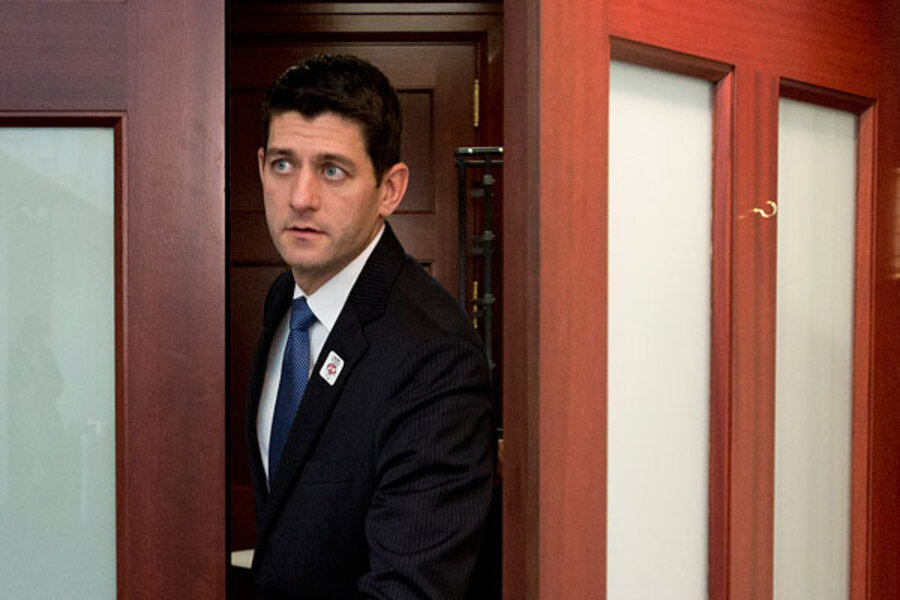Paul Ryan's new Medicare plan could be tip of the iceberg
The arrival of a Republican budget proposal this week, coupled with a rival plan from Democrats, is bringing the volatile issue of Medicare reform to the political forefront.
Paul Ryan, chairman of the House Budget Committee, wants to bring federal deficits down partly by scaling back on government’s health-care promises for seniors. Republicans say that plan will preserve Medicare by keeping the program financially sound.
It's safe to say that Mr. Ryan’s “premium support” model for Medicare – Democrats call it offering a voucher instead of insurance – is destined to generate lots of controversy.
Even if Ryan’s plan is a political nonstarter at present, given Democratic control of the White House and the Senate, the important point may be that Medicare is emerging for serious discussion. President Obama and members of Congress are at least talking about the issue in private meetings.
Budget experts say if there’s any budget issue that deserves the title of “elephant in the room” as a driver of a dangerous expected growth in national debt, it’s health-care programs including Medicare and Medicaid, which provides health insurance for poor Americans.
Adjustments in those programs may or may not happen this year. But there’s wide agreement that cost-saving changes can’t be avoided indefinitely.
“Over the course of coming decades, outlays for Medicare and Medicaid are slated to explode if no action is taken,” said David Greenlaw, an economist at the investment firm Morgan Stanley, in a December analysis of America’s fiscal challenge.
The explosion is already under way, in fact.
What’s still in the future is the point when, if unchecked, the health-care burden could pitch the nation into a fiscal crisis.
A key difference between the government’s two major health-care programs is this: Working Americans pay taxes out of each paycheck to help fund Medicare, as they do for Social Security. Medicaid doesn’t work that way.
But those payroll taxes aren’t paying anything near Medicare’s costs. Republicans point to data showing that a typical retired couple today will have paid only about $1 into the system for every $3 of care they’ll receive (in inflation-adjusted dollars).
So, as a practical matter, the programs are both adding to the national debt.
The cost of Medicare and Medicaid, combined, is on track to equal 9.1 percent of gross domestic product in 2030, up from 5.5 percent of GDP in 2010, according to Mr. Greenlaw at Morgan Stanley, using numbers based on Congressional Budget Office forecasts.
That may not sound huge – but bear in mind that overall health-care spending in America (including in the private sector) already is far higher than in other advanced nations, at nearly one-fifth of GDP.
The projected increase would, by 2030, push public debt up to the point where interest payments become a budget burden in their own right. Overall federal spending would be well above what has become normal in recent decades, even if you assume that big cuts are made in nonentitlement spending.
Some elected officials in both parties are trying to craft a “grand bargain” that would include higher tax revenue (a concession from Republicans) and curbs on entitlement costs (a concession from Democrats). But the two sides are also locked into familiar partisan positions that make a deal difficult.
For his part, Ryan argues that “Medicare is going broke,” as he said on "Fox News Sunday." He said his plan would create choice among “guaranteed coverage options,” with a “total subsidy for the poor and the sick, less of a subsidy for wealthy seniors.”
Many Democrats say the first step should be to look for cost savings within traditional Medicare before considering changes to benefits.
What’s driving up health-care costs?
First, costs are rising. Though the pace of those increases has slowed since the recession – to about 4 percent a year – few experts see that as a permanent downshift.
Costs have been fueled in part by rising insurance coverage. Whereas out-of-pocket costs have remained a relatively small share of overall health spending, since 1960, spending that’s covered by public or private insurance has soared, according to research by economists at the investment firm Goldman Sachs.
A parallel factor is rising income. As a society grows richer, it tends to spend more of its income on health care. Add in demographics (an aging population) and a lack of competition among health-care providers in many markets, and you have a recipe for more people to consume more health-care services at higher prices.









